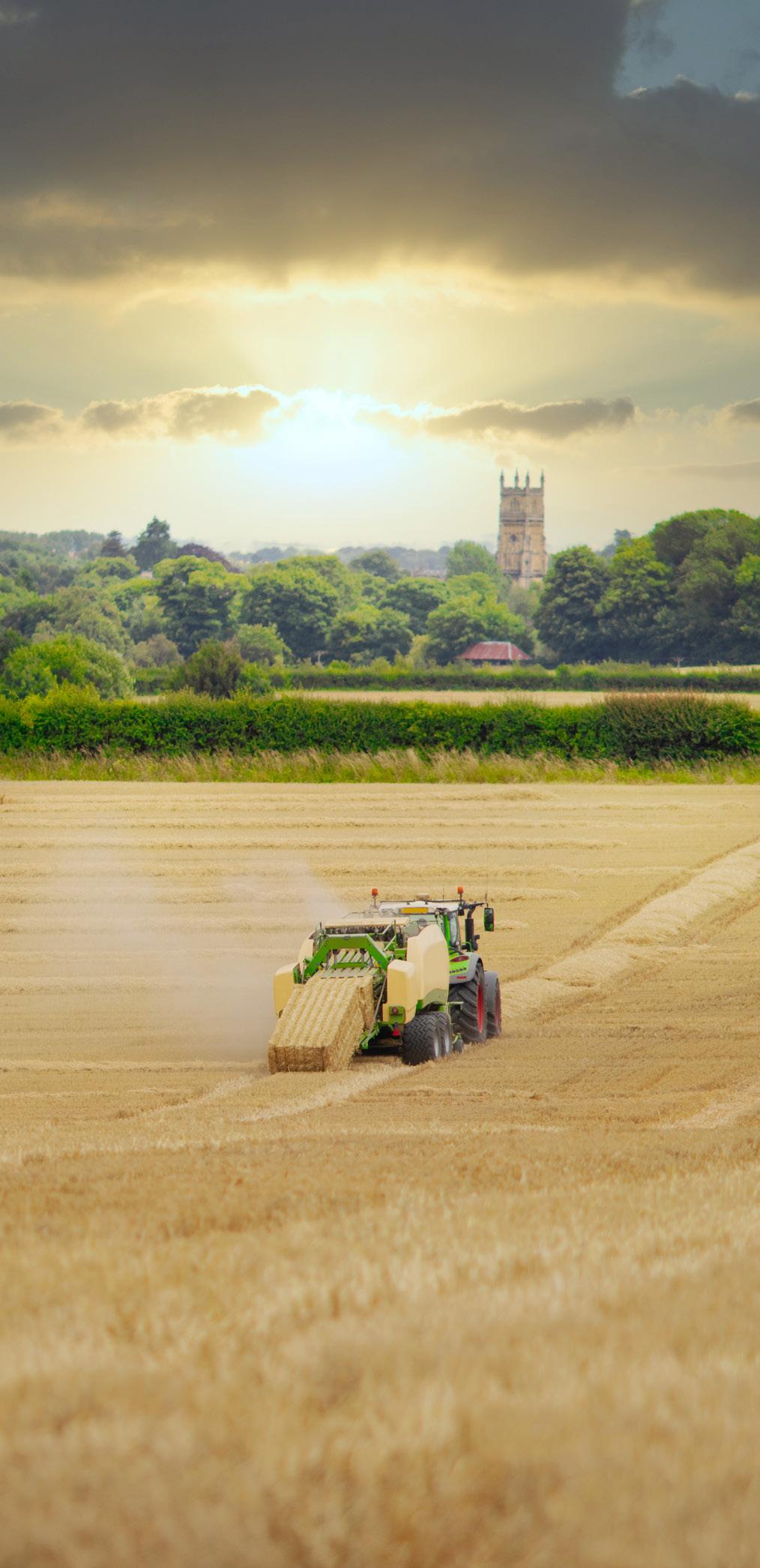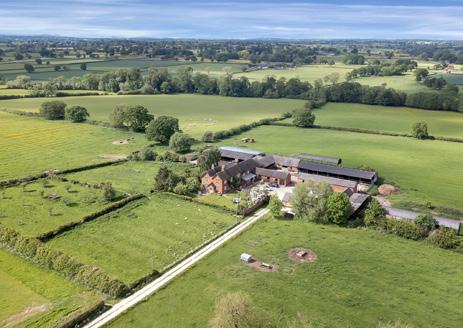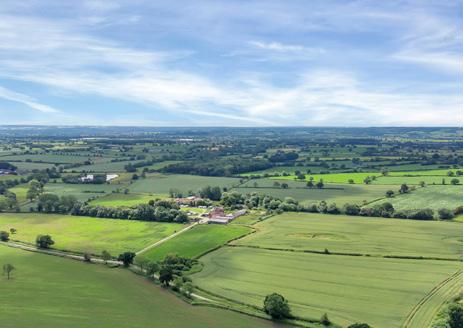Farmland REVIEW 2023

Review of 2022
Outlook for 2023
Agri-business Update
Natural Capital Markets


Review of 2022
Outlook for 2023
Agri-business Update
Natural Capital Markets
The turbulent economic and political events of 2022 appear to have had little impact on the rural and farmland marketplace. With values strengthening in many areas, driven by limited supply and an ever-widening pool of buyers, 2022 produced some excellent results.
Looking ahead, the direction and levels of support available for farming businesses are emerging and many will be contending with reducing subsidy payments over the coming years. Diversification opportunities, alternative income streams and automation have never been more widely discussed as businesses seek to maximise returns from existing assets.
There is continued optimism across our industry. With greater environmental pressures, the need to protect and enhance our natural environment is paramount. Farmland will play a critical role in delivering many of the targets set out in the Environment Act, with carbon capture, conservation and offset opportunities gathering significant attention from a wide spectrum of investors.
In this edition, Matthew Allen looks back over the 2022 Farmland Market. Thomas Parker provides the ‘Area Focus’ this year with an overview of the North East land market. David Kinnersley provides an update on wider farming matters and agricultural policy. Tom Beeley and Alex Watts update on Natural Capital Markets, and we look ahead to the 2023 Farmland Market.

I do hope you enjoy our Farmland Review. Please get in touch if we can assist you in 2023.
Richard Gadd National Country Agency Team01295 226283
richard.gadd@fishergerman.co.uk

The headlines of 2022 will be dominated by the political and economic uncertainty fuelled by the ongoing war in Ukraine which is continuing to have an effect on the supply of commodities and an impact on inflation around the world. However, the UK farmland market during 2022 has seen a slight increase in supply but still at historically low levels with a wide spectrum of buyers still willing to commit for the best opportunities.
There continues to be strong demand from tax-driven ‘rollover buyers’ as they dominate the marketplace for larger-scale commercial farm opportunities. Supply of such opportunities between say 500 and 1000+ acres across the country particularly on the open market continues to remain restricted, but very strong premium per acre prices have been achieved when they do arrive. Equally, the level and value of offmarket sales have been particularly strong throughout the year with fierce competition from motivated buyers in many cases.
We are also still seeing evidence of strategic land buyers remaining inquisitive for medium- and long-term holdings. This was particularly true in the sale of Thurlaston Lodge Farm in Leicestershire with bidding dominated by strategic/development led purchasers.
Demand for carbon offsetting and rewilding opportunities continue, particularly on more marginal holdings. However, with some uncertainty still remaining in the direction of travel for subsidy and environmental payments, this market is perhaps a little more uncertain and hasn’t moved on in 2022 as much as many people had expected.
Non-farming lifestyle and amenity buyers do still remain despite the challenging economic position and hike in borrowing costs, but some of the premiums that were being achieved earlier in the year for smaller residential farms have fallen back a little. However, properties with good, diversified income and the potential to add value remain popular. The sale of the 523-acre Knightwick Manor Estate in Worcestershire was a good example of demand from rollover, expanding farmer and lifestyle buyers competing for a very good quality complete farming estate.
Whilst location generally dictates land values, both scale and quality play significant roles. Average values through 2022 remained stable but in many areas values have strengthened by 5–10%, or more. This is true in some localities where the availability of some larger arable farms during the course of the year has seen some exceptional per acre prices being achieved.
There is, however, still some disparity between those more arable than pasture based farms with pastureland values starting to lag behind in some areas. This is coupled with the more challenging ability for buyers looking to purchase smaller blocks of land struggling to justify the increased finance costs.
It is also worth noting that the demand for established woodland, even without the carbon offsetting opportunities, has increased with values approaching that of good pastureland in some areas.

Values continue to hold firm for those farms with potential strategic value or diverse income opportunities.
Overall the supply of land through 2022 was slightly up on 2021 levels but was somewhat distorted by a few one-off large sales where some company-owned holdings were being consolidated. Q1 and Q2 saw the increase in supply, while things essentially went ‘on hold’ during the middle part of the year with the political and economic disruption dominating the headlines and people’s thoughts. As mentioned there have also been a significant but hard to define number of off-market transactions being conducted which would certainly bolster the overall level of land traded. We expect this trend to continue in 2023 as sellers look for a discreet exit plan.
Matthew Allen National Country Agency Team
01295 271555
matthew.allen@fishergerman.co.uk
If you would like to learn more about these sales or the transactions taking place in your area please call us for a market update.
A strategically located and accessible arable farm with principal Georgian farmhouse and secondary accommodation. In all about 189 acres.




A 246 acre farm which includes a period farmhouse and large range of traditional and modern buildings, within a ring-fence.
Grade II* listed manor house; extensive range of traditional & modern buildings, 6 dwellings, pasture, arable & woodland. In all about 523 acres.

A mixed grassland and arable farm with listed farmhouse in a most desirable location. In all about 100 acres.
A traditional grassland farm with farmhouse, bungalow, outbuildings and land in desirable rural setting. In all about 105 acres.

A multi-faceted residential, commercial and rural property set in circa 64 acres with strong road and rail links.


An attractive and productive block of arable land and woodland extending to about 114 acres.
About 40 acres of permanent pasture, amenity land and woodland, offered in various lots.

About 60 acres of productive grade 1 arable land with woodland.

The North East Agency Team have actively been involved in the purchase and sale of over 1,500 acres in 2022. Operating out of Doncaster and Newark, the team work across South & East Yorkshire, Derbyshire, Nottinghamshire and Lincolnshire, advising farmland buyers and sellers in these areas.

As witnessed nationally, our region has seen a modest increase in the number of acres brought to the market with figures surpassing the volumes offered in 2020 and 2021, although the supply in those years was impacted by the Covid-19 pandemic.
Despite the increase in available land, demand is still very much outstripping supply with a wide range of buyers actively searching for a variety of requirements. Farmers are still the primary buyer of farmland, especially those purchasing land adjacent (or near) to their existing holdings looking to benefit from economies of scale.
Also forming a significant portion of the buyers pool were ‘rollover’ buyers seeking to reinvest the proceeds from the sale of land for development, to defer capital gains tax liability.
Over the last 12 months we have seen a growth in the number of enquiries from nonfarming money such as lifestyle buyers, private investors and corporate bodies. These types of buyer have been targeting holdings that have additional conservation and environmental features, as well as those that offer carbon offsetting opportunities.
This was evidenced when we brought the Land at Old Whittington, Chesterfield to the market. The property comprised three distinct blocks of predominantly arable land totalling about 150 acres and was offered for sale by informal tender, as a whole or in up to three lots. The land lay within a 1.25-mile radius of the built-up area of Old Whittington, with each lot offering something different.
The property generated interest on a local and national level following a public marketing campaign which resulted in offers on the whole and for individual lots. Following the tender deadline and a review of the offers received, a decision was made to sell the property in multiple lots, which achieved a sale well in advance of the guide price.
The above is a prime example of the wide variety of buyers now in the marketplace which has increased competition and invariably contributed in part to the rise in average land values.
Such a competitive marketplace has led to many buyers registering their interest with land agents, with the aim of finding and agreeing sales privately. These deals can often lead to premiums being paid, benefiting both buyer and seller.
In 2022 we were instructed to act on behalf of many buyers in the acquisition of multiple blocks of land and farms across the region. This included the acquisition of properties privately available and on the open market. Such properties have varied in acreage ranging from 50 up to 260 acres, comprising a mixture of arable land, grassland and woodland. We expect the number of deals being undertaken privately to continue to grow especially where discretion from both parties is required.
Looking ahead, we predict more land in the region to be brought to the market as farming businesses feel increased pressure from rising input costs and falling subsidy payments. Although supply is likely to improve, we still expect there to be a shortfall, therefore strengthening values for all land types through 2023.
Thomas Parker DoncasterFollowing a competitive pitch for the sale of the farm we were delighted to secure the instruction for a spring 2022 marketing campaign.
Our instructions were clear: to achieve best value for the farm in a timely manner. We provided clear, honest and informed advice throughout the marketing and sale process.

The farm comprised a 190-acre strategically located and accessible arable farm with principal Georgian residence, farm cottage and more recent barn conversion. The farm benefited from a range of traditional and modern farm buildings including grain store (with development potential STP). The farmland comprised principally grade 3 arable land suited to a combinable cropping rotation.
Prior to our initial pitch meeting, we identified the significant strategic potential for future development (subject to planning) based on proximity to recent allocated sites and excellent access onto the A47, a major arterial route into Leicester.
Our national planning and development team provided a comprehensive report outlining the current constraints and position of the farm in respect of current planning policy. This provided a concise review of the future strategic potential allowing us to advise the client appropriately.
Our extensive marketing report took account of the strategic potential in identifying the most suitable marketing strategy to target those likely investors and buyers. Further, we proposed differing overage provisions across the farm which would still encourage a purchaser/s to extract any future latent value but also protect our client’s future interest appropriately. Our report also considered potential lotting to attract the widest range of buyers.
Timescales were important and we proposed a comprehensive timetable of practical pre-sale
works, data room preparation and accounted for the marketing, advertising and conveyancing process to ensure completion could take place around harvest 2022.
Thorough preparation in this sale was critical with various tenancy matters to conclude, existing contractors to work with, draft legal sale documents to be prepared and data room creation
For every farm and land sale we consider and propose the most thorough marketing and advertising campaign taking account of the farm type, likely buyer profile, value and any additional value the farm may hold. As such, and based on our lotting proposal which would undoubtedly attract farmers including rollover buyers, equestrian buyers, residential buyers, developers, strategic land investors and other conservation-led buyers, we proposed advertising in relevant hard-copy form and online. Our proposals for a detailed sales brochure with professional photography, land registry compliant sales and lotting plans, floorplans and detailed residential and farm building descriptions allowed us to present a complete overview of the farm to prospective purchasers.
Our recommendations to create an online data room to hold pertinent information about the farm from BPS plans to title information, draft contracts, searches, EPCs and draft overage deeds would ensure potential purchasers had access to all relevant information prior to submitting offers, thus shortening the conveyance period and reducing risk.
Our recommendations on likely sale values and guide prices were ascertained from a range of comparable land and residential sale values, local and national market knowledge, residual calculations on the farm buildings (with development potential), and strategic land value evidence. We proposed fixed guide values for
“When I consider engaging professional services I always hope to experience: Honesty, Punctuality, Clarity of thinking, Understanding of complex issues and Timely and effective communication.
Fisher German delivered in all these areas, and I couldn’t have been happier with the services provided. Right from the moment of instruction everything happened as stated. They understood the brief from the outset and delivered a sale well above guide price, whilst minimising stress on the seller.
Thanks to Richard and his team.”
the individual lots and the farm as a whole, at a level to attract maximum interest from the widest spectrum of buyers in the marketplace. In turn, our recommendations on guide values would create competition and extract maximum value through negotiations.
Our marketing strategy was implemented in April 2022 with national coverage in specific hard-copy publications and online portals.
Interest was generated swiftly with around 40 viewings taking place through April and May and offers were received promptly.
We were instructed to negotiate with parties and, following fierce competition, an offer substantially in excess of the £4,050,000 guide price and above the client’s expectations was accepted subject to contract.
Following final due diligence, solicitors were instructed in late June and contracts exchanged and completed later in the year.
Richard Gadd comments: “This sale demonstrated the true and tangible value of cross-divisional support within Fisher German. Our informed and well-researched advice led to a most exciting instruction, and our national marketing campaign, focused on the wide range of potential buyers and with a comprehensive data room available, ensured a strong level of interest from fully informed and genuine parties. The sale outcome was impressive and was the result of a collective effort between all parties involved.”
 Richard Gadd National Country Agency Team
Richard Gadd National Country Agency Team
01295 226283
richard.gadd@fishergerman.co.uk
For those farmers deciding that now is the best time to cease farming and sell or lease their land, the ‘Lump Sum’ BPS subsidy option has been useful. Contracting out operations continues to be a popular retirement route as well.
UK farming has had a range of issues to contend with in 2021/22 from avian influenza to rising energy and fertiliser costs following Russia’s invasion of Ukraine as well as the ongoing Agricultural Transition Plan post Brexit.
While the war in Ukraine, and a weak GBP, have driven inflation in inputs cost, particularly energy and fertiliser, it has also driven arable crop prices with wheat prices increasing from £160-170/t to a peak of £300/t which has helped arable margins.
The dairy, pig and poultry sectors have been challenged most by the rising cost of energy and feed as well as post-Covid supply chain issues and avian influenza. These intensive livestock sectors will take some time for the economics to balance out again and, like
the horticultural sector, are also impacted by the shortage of labour in the UK. Arable farming however, is making good margins even as the Basic Payment Scheme (BPS) subsidy falls.

The post-Brexit agricultural policy seems slow to take shape. However, a chaotic political climate over the last 12 months hasn’t helped the progression of the much talked about ELMS (Environmental Land Management Scheme) with only the Sustainable Farming Incentive (SFI) soils standards and animal welfare elements open for business at the time of writing. The other SFI standards may take longer but the replacement for the Mid Tier Countryside Stewardship schemes could be announced as early as 2023.
What is clear, from rising food inflation and a realisation stemming from Russia’s war in the “breadbasket” of Europe, is that food security is firmly on the agenda again. Hopefully that will be positive for UK food producers despite the rising input costs.
David Kinnersley Agribusiness

Despite recent political upheaval and uncertainty created by Liz Truss’s short-lived government there remains strong interest in UK natural capital markets, in particular carbon, nutrient and biodiversity offsetting. The Environment Act which gained Royal Assent in November 2021 provides the legislative platform for an array of environmental policy. This includes binding targets around biodiversity, air and water quality; the development of Local Nature Recovery Strategies (LNRS); and the introduction of Biodiversity Net Gain (BNG).
While we expect the Act to drive policy making across all government departments, the effects of the Act will be keenly felt in the rural sector where the ability to influence environmental improvement is greatest. This is being seen in the Agricultural Act and the design of the Environmental Land Management scheme (ELMS) already as we transition away from EU-designed support. How private funding will integrate with public funding is a critical question for landowners as they begin to explore these new markets. Until a clearer picture emerges of the new schemes and how they will interact with private funding, many will be reluctant to fully engage in these new markets.
The Environment Act introduces the requirement of BNG to the planning system. It is expected to become mandatory across England from November 2023, but several local planning authorities (LPAs) are already applying net gain policy. Where BNG is applied, developers are required to demonstrate how biodiversity will be enhanced by at least 10% as part of a planning application.

Feedback to date suggests that, whilst LPAs are applying BNG, the mechanisms for delivery remain unclear causing frustration amongst developers trying to navigate the system. Further policy clarity and guidance is required.
In many cases the uplift in habitat values required to demonstrate a net gain will be achieved through on-site enhancement within a development. This means that in many instances only a handful of offsetting credits are required to meet the net gain. Smaller, more constrained sites are likely to have less scope for on-site enhancement so the need for offsetting will be more acute.
A number of business models are materialising for the delivery of biodiversity offsetting including:
• bespoke agreements between landowners and developers to provide the offset needed for a specific planning application;
• lease of land to third parties to develop and sell credits, with the owner of the land receiving a low-risk income payment;
• habitat banking undertaken proactively by a landowner to establish habitat credits for marketing and sale.
Each model comes with advantages and drawbacks, but for many landowners habitat banking could provide an attractive diversification opportunity. Whilst many landowners would be keen to take forward habitat banks, engagement with local authorities is critical and in many areas the resources and mechanisms needed for delivery are not yet established.
LNRS will be key to identifying priority areas for habitat establishment and the types of habitats which are needed. Landowners should keep a close eye on the development of LNRS which could be consequential for habitat values for both offsetting and development sites.
There is currently limited market evidence for offsetting values. The Defra report suggested values of £20,000–£25,000 per habitat unit; however, in reality, values will depend on many variables including habitat type, cost of delivery, land availability and of course supply and demand.
It is not just new habitat that can be used for offsetting; enhancement of existing habitats can also be used to generate credits. This might include reseeding existing grassland with species-rich mixes or improving

management of woodland to enhance the condition and quality of existing habitat. Regardless of market prices, it is vital that landowners pay close attention when determining the price at which credits are sold. Whilst on face value payment may seem attractive, agreements involve legally binding contracts for establishment and management of land for at least 30 years.
It is important to remember that offsetting is not the only option, with funding through ELMS and other grants likely to be available. For woodland creation in particular, significant funding is available as well as an active market for carbon credits which may provide a more attractive route to securing new woodland rather than BNG. Although this remains a nascent market, habitat banking does appear to be an attractive and viable opportunity for many landowners bringing genuine financial benefit for delivery of habitat creation.
Fisher German continues to assist landowners in exploring the opportunities offered by these markets through The Green Offset – a dedicated platform for exploring the natural capital potential of land. To discuss biodiversity offsetting or any other natural capital opportunities please contact Tom Beeley or Alex Watts.
Selling land and property by online auction goes from strength to strength, with transaction numbers up by 30% year on year, a remarkable growth area for Fisher German. As a business, we started to offer online auctions as a new service line before the Covid pandemic, with rural, residential and commercial clients all seeing the benefit of this method of sale. For a seller, there is transparency and certainty to selling by online auction, appealing to private sellers as well as public bodies and charitable institutions who need to be able to demonstrate that the best price has been achieved in the open market. So why are some people nervous about this method of sale? Some may have a phobia about doing everything online, with no personal face-to-face contact, or are just not tech confident – and I get that. A traditional
auction room has a buzz about it and you can see the people in the room; however, the auctions rattle along at such a pace, with no clear picture about who is actually bidding, then the hammer goes down and it’s all over in a matter of minutes and you’re left pondering how you missed out. Buyers through online auction tell us some of the key factors they love about the process are that they can see all the bids clearly displayed on the computer screen and they also have plenty of time to work out their next bid – once the reserve price is met, any additional bid made resets the clock by five minutes, allowing eager buyers gathered around the laptop to have a proper chat about their next offer. Five minutes is quite a long time – try sitting quietly doing nothing for five minutes… it’s longer than you think, isn’t it? Resetting the clock can happen
multiple times as increased offers land, meaning that an online auction can often end 20 to 30 minutes after the published end time. So, if you’re not tech confident, reach out to someone you know who can help you to engage with the online world of online auctions.
As costs of living rise at their fastest rate in decades and interest rates are pushed higher (seven successive rises now up to 3% at the time of writing), the housing market is inevitably being impacted. Fisher German are seeing traditional private treaty sales falter and the rate of fall-throughs go up as mortgage offers are withdrawn. Increasingly vendors are turning to us for advice on our successful online auction service to give them certainty, with some impressive results in recent sales.

Some examples of recent successes include a very appealing block of land, about 1.42 acres of grazing land in Netherseal, Derbyshire, which sold for £117,300 after heated bidding, more than three times the guide price


Land off Swalcliffe Road, Oxfordshire, 22.10 acres of amenity land located in a prime location.

£ Guide Price: £250,000
£ Sold: £298,000
Online auctions offer you the chance to sell your property in a fast, transparent and certain manner – in this increasingly challenging market, that could be good to know. Turn to your local property professionals Fisher German to find out how online auctions can help you.
Demand for farms and land is expected to continue to grow through 2023 from a diverse range of buyers. Taxation-driven ‘rollover’ buyers will continue to seek commercial-sized agricultural land holdings, often outside of their geographical regions.
Current political and economic conditions may see some smaller-scale operators being ‘priced out’ of the market due to ever-increasing costs of borrowing and rising input costs.
In line with the last two years following the coronavirus pandemic, lifestyle buyers will continue to show interest in smaller farms and farmsteads as the desire for flexible and home-based working continues. Amenity buyers will continue to drive demand for smaller bare agricultural land parcels.
Following substantial demand for land holdings from corporate buyers in 2022, evidence suggests that this demand will remain.
Such demand is often fueled by their corporate social responsibility and carbon offsetting requirements. This will bolster the demand for poorer, less productive farmland which may be more susceptible to reducing subsidy payments.
The vendor profile for 2023 is likely to remain much the same as we have seen across 2022. We expect the vast majority of supply this year to arise from smaller to medium-sized farming enterprises, likely offering smaller acreages or parts of existing holdings in order to reduce borrowing costs and/or lower loan repayments. A good proportion of supply is likely to come from farmers looking to retire and we expect some early retirement sales to take place that may otherwise have been planned for 2024 onwards. We will also likely see more institutions trading on farmland, specifically where there are limited opportunities for alternative uses or additional income generation.
On balance we believe there will be a small increase in non-farming investors offering land to the market as returns come under pressure and farmland values remain firm. With reducing yields on their capital investment, such investors may consider alternative asset classes with stronger returns on investment in the short term.

We expect a reasonable increase in supply of farmland to the market in 2023 over and above 2022 levels.
Subsidy payments will reduce further in 2023 and we expect input and energy costs to remain well above average. This continued pressure combined with unstable future commodity prices will inevitably lead to an increase in supply. The increasing average age of the UK farmer, with no succession potential/options in some cases, will lead to an increase in retirement sales and supply of small to medium-sized farms and agricultural land holdings.
Our predictions for the year ahead:
• Increased demand from carbon- and green-led buyers
• Modest increase of land to the marketplace
• Continuing demand for residential farms and amenity land
• Further demand from rollover buyers
• Continued demand for strategic and well-diversified holdings
• Increasing off-market activity
• Demand from conservation-led bodies to increase rapidly
Debt-related sales will also increase supply into the market if inflation remains high in historic terms, and interest rates continue to increase. In addition to this, we may see an increase in lowergrade and hill farms coming to the market where offsetting and carbon-led buyers will be prepared to pay in excess of agricultural value.
Continuing the trend from 2022, a good proportion of trading this year will take place through private transactions, often hidden from the marketplace and thus not truly reflecting the volume of land changing hands.
We expect a small increase in average values in 2023 compared with 2022.
Average values are expected to increase for all land types albeit at varying levels depending on location, scale, quality and accessibility.
We expect arable values to increase steadily based upon the restricted supply across the country and with the pent-up demand following very limited supply over the last few years. We also expect grassland values to increase where there is demand from conservation and carbon-led buyers; this may not be seen across the country.
Evidence would suggest that smaller-scale amenity farms and parcels of amenity land should maintain strong values as demand continues for more space and a tangible investment.
For those considering a sale in the near future, early preparation is key. Please do not hesitate to contact us, in confidence, to discuss your objectives and we would be delighted to advise accordingly.
Patrick Ellicott National Country Agency Team01530 412821

Early evidence suggests increased supply in 2023 with values holding firm.
Richard Gadd National Country Agency Team
01295 226283
richard.gadd@fishergerman.co.uk
Alasdair Dunne National Country Agency Team









01295 228750
alasdair.dunne@fishergerman.co.uk
Patrick Ellicott National Country Agency Team


01530 412821
patrick.ellicott@fishergerman.co.uk
Molly Skinner Bedford

01234 827119
molly.skinner@fishergerman.co.uk
Thomas Parker Doncaster
01302 243913
thomas.parker@fishergerman.co.uk
Robert Hurst Lincolnshire
01636 642504
robert.hurst@fishergerman.co.uk
Tom Dennes
Banbury and Thame
01295 226290
tom.dennes@fishergerman.co.uk
Matthew Barker

West Midlands
01905 459433
matthew.barker@fishergerman.co.uk
Stuart Flint National Country Agency Team

01295 226281
stuart.flint@fishergerman.co.uk
Matthew Allen National Country Agency Team
01295 271555
matthew.allen@fishergerman.co.uk
Ben Longstaff
Ashby de la Zouch and Stafford
01530 410885
ben.longstaff@fishergerman.co.uk

Edward Clark Chester
01244 409665
edward.clark@fishergerman.co.uk
Daniel Hayhurst Knutsford
01565 745326
daniel.hayhurst@fishergerman.co.uk
Rachel Clipsham Newark
01636 642506
rachel.clipsham@fishergerman.co.uk

Christian Sanders Worcester
01905 677351
christian.sanders@fishergerman.co.uk
Thomas Oatey Exeter
01392 314070
thomas.oatey@fishergerman.co.uk